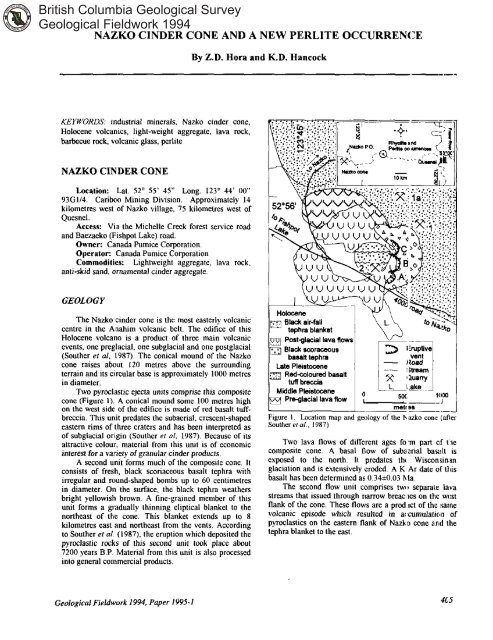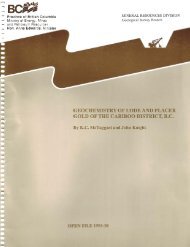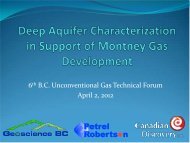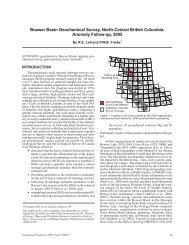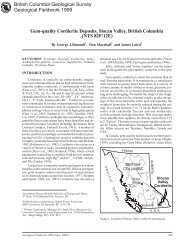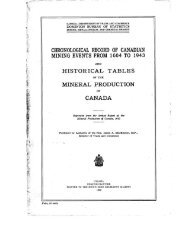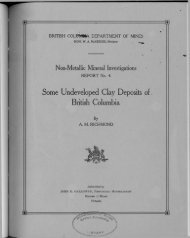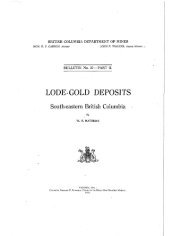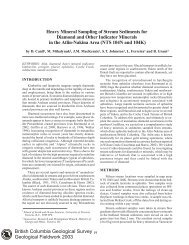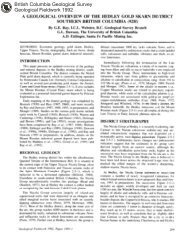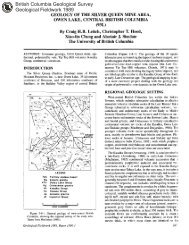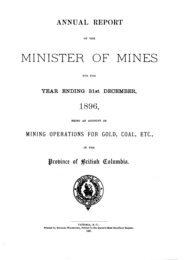Nazko Cinder Cone and a New Perlite Occurrence
Nazko Cinder Cone and a New Perlite Occurrence
Nazko Cinder Cone and a New Perlite Occurrence
You also want an ePaper? Increase the reach of your titles
YUMPU automatically turns print PDFs into web optimized ePapers that Google loves.
NAZKO CINDER CONE AND A NEW PERLITE OCCURRENCE<br />
KEYWORDS: industrial minerals, <strong>Nazko</strong> cinder cone,<br />
Holocene volcanics, light-weight aggregate, lava rock,<br />
barbecue rock, volcanic glass, perlite<br />
NAZKO CINDER CONE<br />
Location: Lat. 52" 55' 45" Long. 123' 44' 00<br />
93G1/4. Carib Mining Division. Approximately 14<br />
kilometres west of <strong>Nazko</strong> village, 75 kilometres west of<br />
Quesnel.<br />
Access: Vi,a the Michelle Creek forest service road<br />
<strong>and</strong> Baezaeko (Fishpot Lake) road.<br />
Owner: Canada Pumice Corporation.<br />
Operator: Canada Pumice Corporation<br />
Commodities: Lightweight aggregate, lava rock.<br />
anti-skid s<strong>and</strong>, ornamental cinder aggregate.<br />
GEOLOGY<br />
The <strong>Nazko</strong> cinder cone is the most easterly volcanic<br />
centre in the Anahim volcanic belt. The edifice of this<br />
Holocene volcano is a product of three main volcanic<br />
events, one preglacial, one subglacial <strong>and</strong> one postglacial<br />
(Souther el a/, 1987). The conical mound of the <strong>Nazko</strong><br />
cone raises about 120 metres above the surrounding<br />
terrain <strong>and</strong> its circular base is approximately 1000 metres<br />
in diameter.<br />
Two pyroclastic ejecta units comprise this composite<br />
cone (Figure 1). A conical mound some 100 metres high<br />
on the west side of the edifice is made of red basalt tuffbreccia.<br />
This unit predates the subaerial, crescent-shaped<br />
eastern rims of three craters <strong>and</strong> has been interpreted as<br />
of subglacial origin (Souther el a/, 1987). Because of its<br />
attractive coloun, material from this unit is of economic<br />
interest for a variety of granular cinder products.<br />
A second unit forms much of the composite cone. It<br />
consists of fresh, black scoriaceous basalt tephra with<br />
irregular <strong>and</strong> round-shaped bombs up to 60 centimetres<br />
in diameter. On the surface, the black tephra weathers<br />
bright yellowish brown. A fine-grained member of this<br />
unit forms a gradually thinning eliptical blanket to the<br />
northeast of th8e cone. This blanket extends up to 8<br />
kilometres east <strong>and</strong> northeast from the vents. According<br />
to Souther et a/, (1987), the eruption which deposited the<br />
pyroclastic rocks of this second unit took place about<br />
7200 years B.P, Material from this unit is also processed<br />
into general commercial products.<br />
Geologicnl Fieldwork 1994, Paper 1995-1<br />
By Z.D. Hora <strong>and</strong> K.D. Hancock<br />
"."<br />
fl Black 0rx)rBcbous > liruptive<br />
basail tephra<br />
Road<br />
~<br />
Figure 1. Location map <strong>and</strong> geology of the hazko COIIB (aller<br />
Souther el ai., 1987)<br />
Two lava flows of different ages fo m part of t le<br />
composite cone. A basal flow of subaerial basalt is<br />
exposed to the north. I1 predates tht Wisconjin:m<br />
glaciation <strong>and</strong> is extensively eroded. A K Ar date of this<br />
basalt has been determined as 0.34*0.03 hla.<br />
The second flow unit comprises two separa1.e lava<br />
streams that issued through narrow breac,les on the wcst<br />
flank of the cone. These flows are a prod Jct of thae !;am<br />
volcanic episode which resulted in arcumulaticm of<br />
pyroclastics on the eastern flank of <strong>Nazko</strong> cone <strong>and</strong> the<br />
tephra blanket to the east.
Photo 1. Unsorted nature of pyroclastic deposit. Black,<br />
scoriaceous basalt tephra, pit I<br />
Photo 2. View of pit la, opened in line pyroclastic layer<br />
Photo 4. Sized red scoria - l<strong>and</strong>scaping aggegate<br />
Photo 5. Sized black scoria - barhewe rock<br />
406 British Columbia Geological Survey Branc,CI
PRODUCTIONAND DEELOPMENT<br />
Canada Pumice Corporation has developed three<br />
production sites in the <strong>Nazko</strong> cone area. The first is a<br />
small pit at the north side of the toe of the volcanic<br />
mound (Photo I). Because of a large number of volcanic<br />
bombs in the unsorted pyroclastic material, this source of<br />
black scoria is now ab<strong>and</strong>oned <strong>and</strong> has been reclaimed.<br />
The company opened a new pit several hundred metres to<br />
the north, where there are no large bombs (Photo 2). On<br />
the south side of the <strong>Nazko</strong> cone, the company operates<br />
another pit as a source of red scoria (Photo 3).<br />
Production equipment consists of a 2 by 3-metre,<br />
minus IO-centimetre grizzly, a Powerscreen double deck<br />
portable screen, a Cat 980B loader <strong>and</strong> a Cat D8<br />
bulldozer. Typncal production is about 115 cubic metres<br />
(150 cu. yards) per day with current annual production of<br />
11 475 cubic metres (15 000 cu yard). Products are<br />
available in four screened sizes <strong>and</strong> also as oversize<br />
l<strong>and</strong>scaping rocks. Most of the present production is used<br />
in decorative applications for l<strong>and</strong>scaping (Photo 4). s<strong>and</strong><br />
traps on golf courses <strong>and</strong> barbecue lava rock (Photo 5).<br />
Other applications include anti-skid highway<br />
traction s<strong>and</strong> <strong>and</strong> light-weight aggregate. While both<br />
colours, black <strong>and</strong> red, are readily available, the greatest<br />
dem<strong>and</strong> so far has been for red cinder products.<br />
PERLITE<br />
Location: Lat. 53" 01' 30" Long. 123" 12' 05"<br />
93B114. Carib Mining Division. Approximately 59<br />
kilometres west of Quesnel.<br />
Access: F'rom Quesnel on <strong>Nazko</strong> road.<br />
Commodities: <strong>Perlite</strong>, volcanic glass.<br />
A previously unreported occurrence of perlite has<br />
been found during a cursory examination of large<br />
rhyolite outcrops <strong>and</strong> an adjacent bank of glacial outwash<br />
exposed in a cut on the road from Quesnel to <strong>Nazko</strong><br />
(Photo 6).<br />
While no bedrock outcrops containing volcanic glass<br />
are known in the area, abundant clasts of perlitic rock<br />
Geological Fieldwork 1994, Papcr 1995-1<br />
can be found throughout the outwash depsit. The large<br />
size of many of the perlite boulders (50 c n in dian&r),<br />
low physical strength ofthe rock <strong>and</strong> pror imity to a lalge<br />
exposure of Eocene rhyolites (Rouse <strong>and</strong> ldathews, 19118;<br />
Tipper, 1961), points to a nearby source most prrbal)ly<br />
associated with the adjacent rhyolite outcr ~ps.<br />
The perlite rock is black to dark green, with<br />
microfractures resulting in platy, rod-lik: <strong>and</strong> isolnelric<br />
fragments. Four distinct types of volcanic glass w,:re<br />
collected for expansion tests.<br />
A sample of each of the four types was crushed to<br />
less than l-centimetre size fragments, which werc: then<br />
placed under a propane torch flame for bout 1 xrinute.<br />
All types exp<strong>and</strong>ed, increasing the volur,le of individual<br />
particles from approximately two to f;wr times their<br />
original size.<br />
The significance of this perlite occunence is that it is<br />
the logistically best-located <strong>and</strong> access ble site 111 the<br />
British Columbia interior. <strong>and</strong> the authm believe: that<br />
prospecting will locate the bedrock sourc: of perlit: rock<br />
in nearby Eocene rocks.<br />
ACKNOWLEDGEMENTS<br />
The authors thank Brian Wear for asisting wlllh the<br />
visit to the <strong>Nazko</strong> propert)..<br />
REFERENCES<br />
Rouse, G.E. <strong>and</strong> Mathews, W.H. (1988) Palynolo,:y <strong>and</strong><br />
Geochronology of liccene Beds from ( heslatta Fds <strong>and</strong><br />
<strong>Nazko</strong> Areas, Central British Co umba; Ccnadian<br />
Journal of Earl/] Sciences, Volume 25, pager 1:!68-<br />
1276.<br />
Souther, J.G., Clague, J.J. <strong>and</strong> Mathewes, R W. (1987) Nilzko<br />
<strong>Cone</strong>: A Quaternary Volcano in l h r Eastern Anshim<br />
Belt; Canadian Journal of Earth Scb nces, Volune 24,<br />
pages 2477-2485.<br />
Tipper, H.W. (1961): Prince George, Bntislt Columbi:; Sheet<br />
93G; Geological S~rvvqv ofCanada, b ap 49-191XI
NOTES


